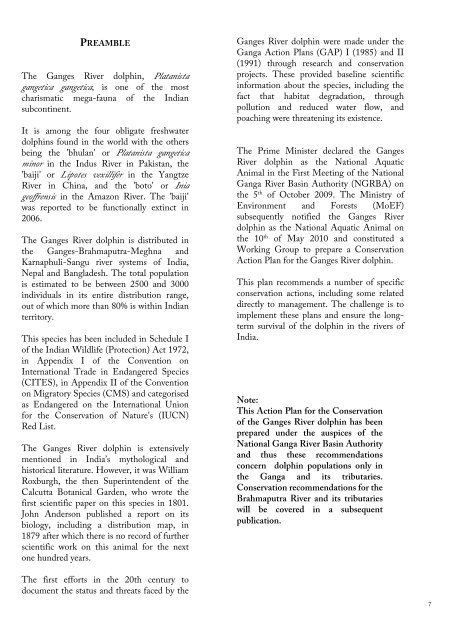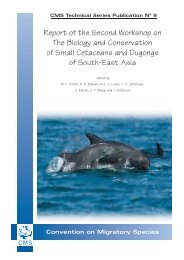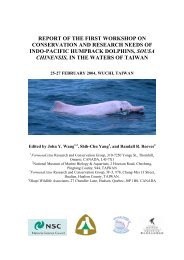the conservation action plan the ganges river dolphin - IUCN SSC ...
the conservation action plan the ganges river dolphin - IUCN SSC ...
the conservation action plan the ganges river dolphin - IUCN SSC ...
You also want an ePaper? Increase the reach of your titles
YUMPU automatically turns print PDFs into web optimized ePapers that Google loves.
PREAMBLEThe Ganges River <strong>dolphin</strong>, Platanistagangetica gangetica, is one of <strong>the</strong> mostcharismatic mega-fauna of <strong>the</strong> Indiansubcontinent.It is among <strong>the</strong> four obligate freshwater<strong>dolphin</strong>s found in <strong>the</strong> world with <strong>the</strong> o<strong>the</strong>rsbeing <strong>the</strong> 'bhulan' or Platanista gangeticaminor in <strong>the</strong> Indus River in Pakistan, <strong>the</strong>'baiji' or Lipotes vexillifer in <strong>the</strong> YangtzeRiver in China, and <strong>the</strong> 'boto' or Iniageoffrensis in <strong>the</strong> Amazon River. The 'baiji'was reported to be functionally extinct in2006.The Ganges River <strong>dolphin</strong> is distributed in<strong>the</strong> Ganges-Brahmaputra-Meghna andKarnaphuli-Sangu <strong>river</strong> systems of India,Nepal and Bangladesh. The total populationis estimated to be between 2500 and 3000individuals in its entire distribution range,out of which more than 80% is within Indianterritory.This species has been included in Schedule Iof <strong>the</strong> Indian Wildlife (Protection) Act 1972,in Appendix I of <strong>the</strong> Convention onInternational Trade in Endangered Species(CITES), in Appendix II of <strong>the</strong> Conventionon Migratory Species (CMS) and categorisedas Endangered on <strong>the</strong> International Unionfor <strong>the</strong> Conservation of Nature's (<strong>IUCN</strong>)Red List.The Ganges River <strong>dolphin</strong> is extensivelymentioned in India’s mythological andhistorical literature. However, it was WilliamRoxburgh, <strong>the</strong> <strong>the</strong>n Superintendent of <strong>the</strong>Calcutta Botanical Garden, who wrote <strong>the</strong>first scientific paper on this species in 1801.John Anderson published a report on itsbiology, including a distribution map, in1879 after which <strong>the</strong>re is no record of fur<strong>the</strong>rscientific work on this animal for <strong>the</strong> nextone hundred years.Ganges River <strong>dolphin</strong> were made under <strong>the</strong>Ganga Action Plans (GAP) I (1985) and II(1991) through research and <strong>conservation</strong>projects. These provided baseline scientificinformation about <strong>the</strong> species, including <strong>the</strong>fact that habitat degradation, throughpollution and reduced water flow, andpoaching were threatening its existence.The Prime Minister declared <strong>the</strong> GangesRiver <strong>dolphin</strong> as <strong>the</strong> National AquaticAnimal in <strong>the</strong> First Meeting of <strong>the</strong> NationalGanga River Basin Authority (NGRBA) on<strong>the</strong> 5 th of October 2009. The Ministry ofEnvironment and Forests (MoEF)subsequently notified <strong>the</strong> Ganges River<strong>dolphin</strong> as <strong>the</strong> National Aquatic Animal on<strong>the</strong> 10 th of May 2010 and constituted aWorking Group to prepare a ConservationAction Plan for <strong>the</strong> Ganges River <strong>dolphin</strong>.This <strong>plan</strong> recommends a number of specific<strong>conservation</strong> <strong>action</strong>s, including some relateddirectly to management. The challenge is toimplement <strong>the</strong>se <strong>plan</strong>s and ensure <strong>the</strong> longtermsurvival of <strong>the</strong> <strong>dolphin</strong> in <strong>the</strong> <strong>river</strong>s ofIndia.Note:This Action Plan for <strong>the</strong> Conservationof <strong>the</strong> Ganges River <strong>dolphin</strong> has beenprepared under <strong>the</strong> auspices of <strong>the</strong>National Ganga River Basin Authorityand thus <strong>the</strong>se recommendationsconcern <strong>dolphin</strong> populations only in<strong>the</strong> Ganga and its tributaries.Conservation recommendations for <strong>the</strong>Brahmaputra River and its tributarieswill be covered in a subsequentpublication.The first efforts in <strong>the</strong> 20th century todocument <strong>the</strong> status and threats faced by <strong>the</strong>7





